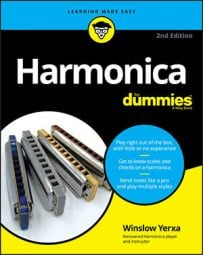When you move air through the harmonica, you get the best results when you breathe gently and deeply through a wide air conduit with no obstructions and no leakage. Here’s a few ways to accomplish these goals.
You can see these three breathing techniques for harmonica players in action in Chapter 3, Video Clip 0302.
Yawning big
Try yawning — it’s catching, isn’t it? One person in a room can yawn, and in moments, everyone is doing it. So try it and note what happens. Your mouth and throat open way up to let lots of oxygen flow in easily. Then, as the yawn subsides, you feel a wave of relaxation — nice, isn’t it?
That open-throated, free flow of oxygen is something you can call the fat pipe. You can move a lot of air gently, with nothing to impede its flow. At the same time, sound waves can move deep into your lungs and resonate.
When you breathe gently with an open throat, air moves silently. If you can hear air moving when you breathe, try opening your throat with a yawn and then holding it open so that air can move noiselessly without any obstruction.
Of course, you can’t play harmonica with your mouth wide open. So try letting your throat open in a yawn while you keep your lips a finger’s thickness apart.
Closing your nose with the balloon exercise
When you play the harmonica, any air not going through the harmonica is leakage that weakens the sound and robs you of staying power. That includes any air going through your nose. If you’re not used to closing off airflow through your nose, how can you learn it? Try the balloon exercise.
The balloon exercise doesn’t use a balloon. Just hold your lips together or apply them to the back of your hand and pretend you’re blowing up a balloon. The air can’t go anywhere, so your cheeks puff up like a balloon. Now try to inhale — your cheeks will suck in. If you can successfully do the balloon exercise, you can play harmonica with your nose closed.
Breathing gently with the warm hand exercise
Harmonica reeds are tiny, and you don’t need to breathe hard to make them sound. In fact, too much air makes them bray instead of sing and can wear them out prematurely. It’s surprising how little breath you need to excite harmonica reeds into vibration. The warm hand exercise gives you a starting point to gauge how gently to breathe when you play the harmonica.
Hold the palm of your hand about two fingers’ thickness from your mouth. Now gently breathe on your hand. If you breathe gently enough, you can feel the warmth of your breath but not the force of the moving air. Now try the same thing inhaling — you have to imagine the effect, but the point is to both exhale and inhale gently.
Later on, when you pick up the harp and start to play, try the warm hand exercise before you start to breathe through the harp, and start playing with the same amount of airflow.
Deepening your breathing
Your air column starts at the bottom of your lungs and extends to your lips. When you get the entire air column moving, you magnify your sound and harness the mass of air in your lungs to gently exert control over the harmonica. To get started follow these steps:
Stand or sit up straight with your head erect and your eyes facing an imaginary horizon in the distance.
Breathe in slowly and gently and feel your rib cage and your abdomen expand.
Exhale gently and allow your abdomen to deflate inward, but keep your rib cage and shoulders expanded.
Don’t allow your rib cage to become rigid. Let it be relaxed and expanded at the same time.
Keep breathing deeply and evenly from your abdomen with your shoulders relaxed and your chest expanded. Now pay close attention to your breathing by doing the following:
Let your abdomen do all the work.
Let your abdomen expand as you breathe in and contract as you breathe out. This gentle, deep breathing gives you a lot of oxygen and gives the sound from the harmonica a big space to vibrate.
Avoid letting your shoulders and rib cage heave up and down as you breathe in and out. By letting your abdomen do the work, you save effort and allow for efficient motion.
Breathe evenly and sustain the airflow.
Each breath should have the same intensity from beginning to end. Avoid sudden bursts as you begin a new breath.
To get a full, singing sound out of the harmonica, start a note and then keep breathing until it’s time to play the next note.
Take long breaths so that you can feel the air in motion. While you breathe, observe your sensations.
Try to take at least three seconds as you inhale and three more seconds as you exhale. You can try breathing longer, but only if you’re able to keep the entire breath relaxed and at an even intensity. If you’re gasping or having difficulty making your breath last the full count, try beginning the breath with a lower volume of air and count to two instead of three.
Breathing forcefully with the dastardly laugh
The evil genius knows how to use his diaphragm, the muscle that drives deep breathing. You can harness the same power to enrich your harmonica sound. You can start to deepen your breathing by following these steps:
Try saying “Hah!” Do it a few times with your hand on your abdomen.
Notice how that area bounces outward when you make that forceful sound. This is your diaphragm expelling air from your lungs.
Try suddenly inhaling, as if you’ve just been surprised.
Notice how your diaphragm suddenly contracts inward, pulling air into your lungs.
Using your diaphragm thrusts to start notes puts a lot of oomph into your sound.

